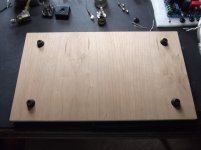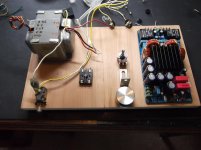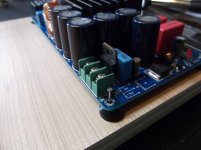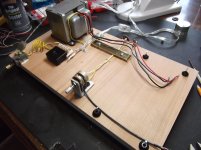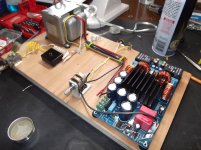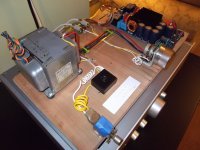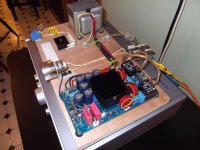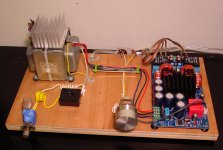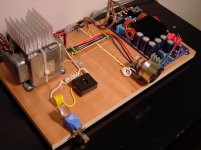share your impressions
Have anyone else built the T4? What about your opinion?
Did you, Jack C.?
@HiFimeDIY: if you want to make an improvement on your already (very?) good amp boards, put some on-board switch to change gain: someone doesn't have source with max out at 1,7V!
UP!...
Actually, I wanted to encourage other possible owners of T4 to share their impressions...
Have anyone else built the T4? What about your opinion?
Did you, Jack C.?
@HiFimeDIY: if you want to make an improvement on your already (very?) good amp boards, put some on-board switch to change gain: someone doesn't have source with max out at 1,7V!
Jack Caldwell & Kristleifur,
Thanks for the further thoughts on the PSUs. Interesting Jack that you found SQ to be improved with a supply that is way above what is theoretically needed. Just to confirm is this the kind of improvement that is quite obvious, or is it the kind that when you A/B a few times you say, "Well I think it's better"? If it's a fairly noticable improvement then some overkill on amperage may be worth it.
Rod
Thanks for the further thoughts on the PSUs. Interesting Jack that you found SQ to be improved with a supply that is way above what is theoretically needed. Just to confirm is this the kind of improvement that is quite obvious, or is it the kind that when you A/B a few times you say, "Well I think it's better"? If it's a fairly noticable improvement then some overkill on amperage may be worth it.
Rod
Recession Amplifier Ver. 1.1
The amp arrived yesterday...excellently packed.
While I select a case, toroidal, etc., I decided to go through my parts bin (junk pile) to build a costless prototype. I found a transformer on a broken Onkyo TX-31, has main output 31-0-31 AC, so cool, the T4 can work with this. Found ALPS switch and 100K ohm dual gang potentiometer probably from a vintage Sansui, some RCA inputs from a Hafler, an Aluminum knob from a Pioneer, and the ever necessary lamp cord. So here it is, 100% recycled parts prototype except for the HIFIMeDIY T4 amp board.
Tested voltage and set DC offset to zero, very easy and steady.
How does it sound? Incredibly good and powerful!
The transformer is a bit warmer than I like, but it has no metal case to take the heat away.
Please keep us up to date regarding this. I am not quite satisfied with the torroidal supply as I wrote just in the beginning of this thread:
http://www.diyaudio.com/forums/class-d/187227-hifimediy-t4-board.html#post2541289
The amp arrived yesterday...excellently packed.
While I select a case, toroidal, etc., I decided to go through my parts bin (junk pile) to build a costless prototype. I found a transformer on a broken Onkyo TX-31, has main output 31-0-31 AC, so cool, the T4 can work with this. Found ALPS switch and 100K ohm dual gang potentiometer probably from a vintage Sansui, some RCA inputs from a Hafler, an Aluminum knob from a Pioneer, and the ever necessary lamp cord. So here it is, 100% recycled parts prototype except for the HIFIMeDIY T4 amp board.
Tested voltage and set DC offset to zero, very easy and steady.
How does it sound? Incredibly good and powerful!
The transformer is a bit warmer than I like, but it has no metal case to take the heat away.
Attachments
Last edited:
But if one supply out of four goes down I still can run 3/4 of the system. If one out of one goes down..............
Rod
Gooswing's comment is an important one and deserves a bit of expanding, imo. With four supplies, you are also 4x more likely to have a fail at some point. This is a typical scenario that has to be considered in servers with RAID arrays. While you may have more redundancy, the less parts you have the less chance you have statistically of a failure occurring. Keeping systems simple is one of the best ways to increase reliability.
And if one of 4 went down would you actually still want to listen to the system?
Last edited:
Gooswing's comment is an important one and deserves a bit of expanding, imo. With four supplies, you are also 4x more likely to have a fail at some point. This is a typical scenario that has to be considered in servers with RAID arrays. While you may have more redundancy, the less parts you have the less chance you have statistically of a failure occurring. Keeping systems simple is one of the best ways to increase reliability.
And if one of 4 went down would you actually still want to listen to the system?
Very good point on the 4x failure potential with 4 supplies. KISS is good, I agree!
If one of the four went down, yes I would still use the system. We use it for all our TV/Home Theater/Music and it's on almost daily. For WAF I need to keep it running. So with one down if I didn't have a spare I would probably just tap the dead channel onto a working supply temporarily. Especially if they are oversized supplies.
You have injected another useful part of the equation here and I thank you. I am beginning to think this is a little like the "Which is better, a Ford or Chevy?" argument. No clear cut answer, at least in my mind.
Rod
Isn't there some Science of Probability skilled man? We could estimate the probability to go down of a single PSU, then our mathematician will calculate which is the best configuration: 1, 2, 3 or 4 PSUs and in which way they must be wired.
There is that nasty word 'best' again
If you are concentrating on reliability and ability to continue despite component failure (an odd sort of aspiration in audio) a good solution is always:
a) Two power supplies each of which has enough capacity to power the whole system. That way you get 'resilience' (another odd concept in audio) whilst only having two supplies give the minimum chance of failure for systems with multiple supplies.
b) Three supplies, each able to power the whole system is perhaps even more resilient. Two can break and you can still run, although the chance of one breaking is higher - unless you just keep the third supply in the cupboard and don't use it.
c) Four supplies, two of which together can power the system would also be pretty good, and suit some layouts better.
(a) is pretty much my preferred option. but not for any 'resilience' reasons, which I think are quite ridiculous in hi-fi really
Degree of change in PSU?
When it comes to SLA vs LFP batteries, yes the improvement was big. Also between LFP over SMPS.
Choosing between smps of the same good brand (Meanwell) was still noticeable but less of a contrast. Maybe less obvious with Christi's supplies, but I haven't tried those...yet.
However, the cost of a 600W PSU is often only a few more $ than a 300W PSU, making it less of an issue to pile on the overkill!
BTW, a big shout-out to Whaleman, I like that Franken-T !
It's only my experience, but it may be useful:Jack Caldwell & Kristleifur,
Thanks for the further thoughts on the PSUs. Interesting Jack that you found SQ to be improved with a supply that is way above what is theoretically needed. Just to confirm is this the kind of improvement that is quite obvious, or is it the kind that when you A/B a few times you say, "Well I think it's better"? If it's a fairly noticable improvement then some overkill on amperage may be worth it.
Rod
When it comes to SLA vs LFP batteries, yes the improvement was big. Also between LFP over SMPS.
Choosing between smps of the same good brand (Meanwell) was still noticeable but less of a contrast. Maybe less obvious with Christi's supplies, but I haven't tried those...yet.
However, the cost of a 600W PSU is often only a few more $ than a 300W PSU, making it less of an issue to pile on the overkill!
BTW, a big shout-out to Whaleman, I like that Franken-T !
There is that nasty word 'best' again
If you are concentrating on reliability and ability to continue despite component failure (an odd sort of aspiration in audio) a good solution is always:
a) Two power supplies each of which has enough capacity to power the whole system. That way you get 'resilience' (another odd concept in audio) whilst only having two supplies give the minimum chance of failure for systems with multiple supplies.
b) Three supplies, each able to power the whole system is perhaps even more resilient. Two can break and you can still run, although the chance of one breaking is higher - unless you just keep the third supply in the cupboard and don't use it.
c) Four supplies, two of which together can power the system would also be pretty good, and suit some layouts better.
(a) is pretty much my preferred option. but not for any 'resilience' reasons, which I think are quite ridiculous in hi-fi really
Of course "best" in Hi-Fi is a nasty word -but I think that under strict requests there isn't much to seek (so in this case word "best" would better fit)-, however I was referring only at the mathematical point of view...sort of a joke.
I think that if you chose option b) or c), the so high extra power would be totally useless a probability to get fault increases.
So I agree, if for Nwboater resilience and reliabilty are important features, option a) would be a good choice.
So here it is, 100% recycled parts prototype except for the HIFIMeDIY T4 amp board.
Tested voltage and set DC offset to zero, very easy and steady.
How does it sound? Incredibly good and powerful!
The transformer is a bit warmer than I like, but it has no metal case to take the heat away.
Thanks for telling us your impressions and sharing some pics. If I have more time I will target my T4 projekt again. My first built was more a quick test.
I am not sure if every T4 user really hook them up with 8 ohm speakers.
I really don't know...someone said that sta517b sounds better. But actually it's the only person I read about and I don't know on the basis of what he thinks so...
try to take a look at datasheets and consider cost, pot.....
(personally I would go with more power, at least for this reason).
However a comparison would be interesting. If someone could....
However not always power=SQ (see TA2024...)
try to take a look at datasheets and consider cost, pot.....
(personally I would go with more power, at least for this reason).
However a comparison would be interesting. If someone could....
However not always power=SQ (see TA2024...)
I don't know the price difference, but if the price difference is insignificant to you, then take the T4.
Advantages:
- More flexibility w.r.t. speaker choice - you can use lower impedances and less sensitive speakers in the future
- Sound quality is significantly affected by rail voltage. The sound changes from 60% of full power to 80% of full power to 100% power mandated by voltage rails. The "bottom" 60% have very low distortion; If you can, you want to keep the amp operating in that range all the time. Even if you don't get a higher wattage supply, or ever use the last 40%, a higher voltage will usually translate into better sound. The T4 allows you to do that.
Advantages:
- More flexibility w.r.t. speaker choice - you can use lower impedances and less sensitive speakers in the future
- Sound quality is significantly affected by rail voltage. The sound changes from 60% of full power to 80% of full power to 100% power mandated by voltage rails. The "bottom" 60% have very low distortion; If you can, you want to keep the amp operating in that range all the time. Even if you don't get a higher wattage supply, or ever use the last 40%, a higher voltage will usually translate into better sound. The T4 allows you to do that.
It's only my experience, but it may be useful:
When it comes to SLA vs LFP batteries, yes the improvement was big. Also between LFP over SMPS.
Choosing between smps of the same good brand (Meanwell) was still noticeable but less of a contrast. Maybe less obvious with Christi's supplies, but I haven't tried those...yet.
However, the cost of a 600W PSU is often only a few more $ than a 300W PSU, making it less of an issue to pile on the overkill!
BTW, a big shout-out to Whaleman, I like that Franken-T !
Thanks Jack and folks for the positive comments on the Franken-T. Its case arrived today.
So, what do you all think:
Option A: 330 VA toroidal
Option B: 500 VA toroidal
Option C: 625 VA toroidal
With:
1. Use the amp's own rectifier and capacitance, about 7,200 uF and feed AC straight from the toroidal.
or
2. Use my own rectifier bridge (heavy duty) and add 20-40,000 uF and feed DC into the amp?
I just don't know the amp draw of this amplifier, anyone measure it at over 1/2 output power?
Compared to the T1, the T4 sounds very authoritative and convincing. If you can afford it, go with the T4. The T1 is very good, but the shock factor belongs to the T4. JMO.
BTW, Franky got a heat sink. Pics below.
Attachments
Last edited:
I don't know the price difference, but if the price difference is insignificant to you, then take the T4.[\quote] Thank you, Sir. I will follow your suggestions! The T4 has even more advantages: - No potentiometer. Not needed for me cause PC is used for volume control. - No power switch. Useless. Power must be switched before the power supply. - Eats AC and DC and can be connected to symetric power supply. - Much better value for the eye. -Thank you! Sorry, formatting won't function - dont know what to do.
Thanks Jack and folks for the positive comments on the Franken-T. Its case arrived today.
So, what do you all think:
Option A: 330 VA toroidal
Option B: 500 VA toroidal
Option C: 625 VA toroidal
With:
1. Use the amp's own rectifier and capacitance, about 7,200 uF and feed AC straight from the toroidal.
or
2. Use my own rectifier bridge (heavy duty) and add 20-40,000 uF and feed DC into the amp?
I just don't know the amp draw of this amplifier, anyone measure it at over 1/2 output power?
Compared to the T1, the T4 sounds very authoritative and convincing. If you can afford it, go with the T4. The T1 is very good, but the shock factor belongs to the T4. JMO.
BTW, Franky got a heat sink. Pics below.
The amp draws at full power something like 400W (360W+360*10% of heat -assuming 90% efficiency). At half power shouild be around 200...250W...never measured.
Hence I would use 500VA toroidal. I think that 7200uF are too little...at least 4700uF more would have been acceptable. I would go with 20/40000uF. But -just as an experiment- try also without your alimentation board...I'm courious to know how much difference can be heard....I will wait your response about this...and an updated opinion about SQ, after 100h breaking-in. I heard SQ getting better exponentially.
Whaleman, may I ask you for a photograph of the soldering site of the board?
Mainly of the power connection part.
If you want to add some uF, there are two ways:
-Use the build in rectifier and solder some cable to the bottom of the capacitor to support external capacitors.
-Unsolder rectifier and use external rectifier and capacitors.
What voltage are the torroids going to have? 36V? I could go for 450VA 2x30V 2x36V 2x42V 5,4A specialized premium High End torroids. That should be enough, I hope.
Mainly of the power connection part.
If you want to add some uF, there are two ways:
-Use the build in rectifier and solder some cable to the bottom of the capacitor to support external capacitors.
-Unsolder rectifier and use external rectifier and capacitors.
What voltage are the torroids going to have? 36V? I could go for 450VA 2x30V 2x36V 2x42V 5,4A specialized premium High End torroids. That should be enough, I hope.
- Status
- This old topic is closed. If you want to reopen this topic, contact a moderator using the "Report Post" button.
- Home
- Amplifiers
- Class D
- Hifimediy T4 board
